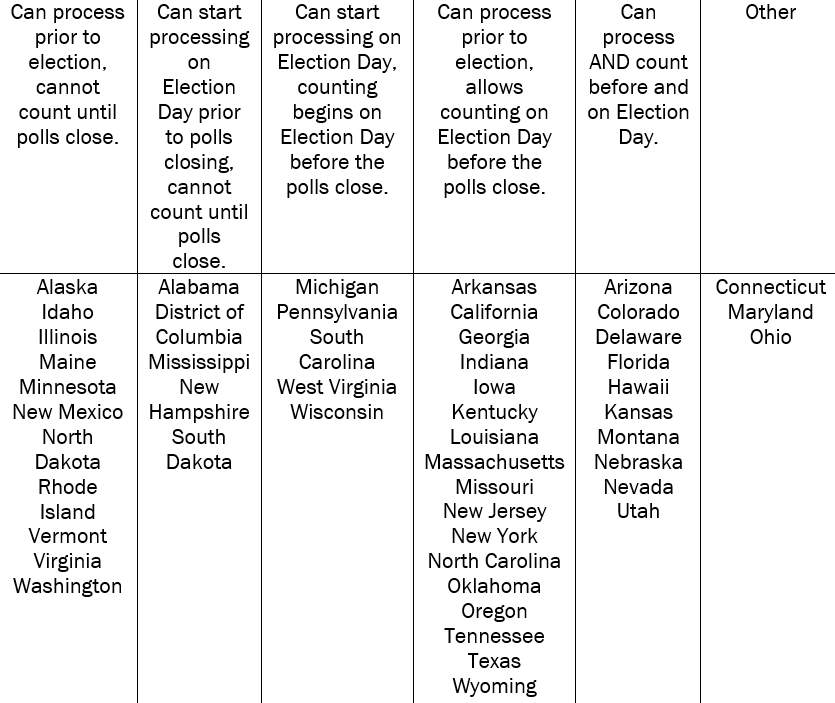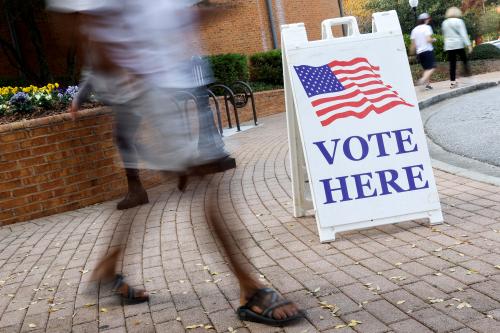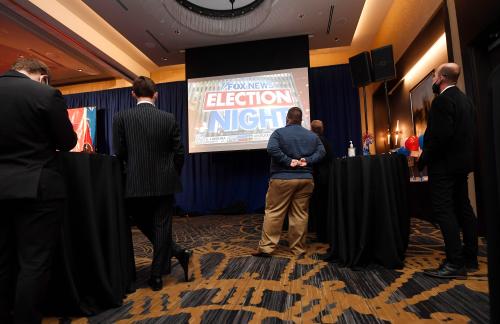The chances of knowing which party will control the U.S. Senate on election night 2022 is increasingly small, and the chances of knowing who won every single U.S. House and statewide race is zero. As Americans we should not consider that evidence of fraud, instead, we should understand it to be evidence of a careful, successfully administered, functional election. And as citizens, we have an obligation to push back against those who falsely and recklessly paint that scenario as something uncommon, unforeseen, and sinister.
In 2020, election night became “election week” as the counting of absentee ballots across a bevy of close states delayed most networks declaring who won the presidency and certain close House and Senate races. Since 2020, misinformation, disinformation, election-related conspiracy theories, and election denialism has thrived, and they will be a vocal minority once again after the election.
One of the driving factors—beyond dishonest social media environments and political leaders on the right failing to disavow misinformation sufficiently—is the manner in which the design of vote counting provides a false basis to fuel claims of election fraud. On this blog last week, my colleague Elaine Kamarck wrote about “the red mirage” in 2020, in which many voters saw Republicans ahead early on election night as in-person, Election Day votes were counted first in many states, and as the more Democratic-heavy early and absentee votes were counted, Republican candidates’ leads shrunk and, in many cases, reversed. This scenario fit nicely into an already molded political disinformation environment that pre-emptively claimed anti-GOP voter fraud.
Sadly, this election night will be no different.
According to the National Conference of State Legislatures, there are numerous ways in which states are required to process and/or count early and absentee ballots. Some states can process these ballots prior to Election Day, while others cannot even begin processing those ballots until Election Day. The counting of early and absentee ballots varies, too. Some states can begin counting prior to Election Day (although results are not made public). Other states can begin counting prior to polls closing on Election Day, but not prior to that date. Still others cannot begin counting votes until after polls close on Election Day.
As the table below shows, the intersection of the timing of processing and counting of early and absentee votes varies dramatically. In some states, early and absentee ballots cannot be processed until Election Day and cannot be counted until after the polls close on election night.
The timing and processing of mail/absentee ballots (2022)

Prior to the 2020 election, few people voted early or absentee. However, because of COVID-19, many state legislatures, governors, and other election officials implemented measures to make voting early or by absentee much easier, in an effort to make voting safer for one’s personal health. This swelled the number of voters using early and absentee methods, to historic levels. According to the New York Times, more than 101 million Americans voted in this way in 2020.
Between 2020 and 2022 many states kept in place numerous changes to their voting procedures, making early and absentee voting much easier. While fewer people will take advantage of these procedures both because fewer votes will be cast in the 2022 midterms, relative to the 2020 presidential, and the share of in-person Election Day voters is expected to be higher this year than two years ago, early and absentee voters are expected to be dramatically higher than in 2018 and all previous elections. This reality puts significant pressure on state, county, and local election administrators to count millions of votes as quickly as possible. It also means in close races the true outcome may not be known for days. This is made more difficult in the many states in which mail-in absentee votes can still be accepted for days or even weeks after Election Day, so long as the ballot is postmarked on or before November 8. (A policy that applies to civilian and especially military ballots.)
Of the 11 states with competitive U.S. Senate and/or governors races, seven can begin processing early and absentee ballots early.[i] Four—Michigan, New Hampshire, Pennsylvania, and Wisconsin—can only begin processing and counting ballots on Election Day. New Hampshire cannot even begin counting them until the polls close that night. Three other states—Georgia, North Carolina, and Texas—cannot count their pre-processed ballots until Election Day. It is no coincidence that many of these states were ground zero for 2020 election lawsuits, conspiracy theories and denialism, as Democratic-heavy early and absentee ballots were counted more slowly than in-person Election Day votes.
In 2020, this led to numerous false theories about fake, illegal, and foreign ballots, etc. being “found” after the election which favored Democrats. While election officials in many states have publicly begged for patience from the public in their counting—misinformation and disinformation, compounded by Americans’ expectations that they will know the winners of all races on election night fosters an environment of distrust in elections systems and results. This election will be no different.
So, what are we to do to help Americans gain greater trust in elections, especially as unprecedented numbers of people vote early and by absentee ballot in ways that overwhelm the capacity of state, county, and local election officials, observers, and vote counters? Last week on this blog, my colleague, Elaine Kamarck, argued that we should cancel “election night”—meaning that states should not report any of the vote until all the votes are counted. I agree with Kamarck that this would cut down on voters’ perceptions of the “red mirage” and other similar phenomena. However, I strongly disagree with this recommendation. In a new democracy, such a process could work, but Americans are socialized into hearing (some) vote tabulations on election night, and further driving vote totals into the shadows and into an information vacuum would heighten—not lessen—voter skepticism, conspiracy theories, election disinformation, etc.
Instead, there should be a combined onus on candidates, elections officials, social media platforms, and especially traditional media to inform voters in much more effective ways about what the rules are in certain jurisdictions. Each has utterly failed voters in the last two elections cycles. Disclaimers on Election Day and night and in the days following about vote counting procedures and historical trends in early and absentee voting should be continuous. Editors’ notes and disclaimers atop print media should become the norm. Banners targeted to social media platforms based on user location should be seen as a service to the public and to the health of the democracy. These are not difficult asks, and private firms should see this as a patriotic duty, required of them for the price of doing business in a functional democracy.
[i] The eleven states are Arizona, Florida, Georgia, Michigan, Nevada, New Hampshire, North Carolina, Ohio, Pennsylvania, Texas, and Wisconsin. While other states may be considered close based on a few polls, these states have consistently remained close throughout the cycle or have narrowed significantly in recent weeks based on multiple polls.






Commentary
Why we won’t know much on election night
November 7, 2022